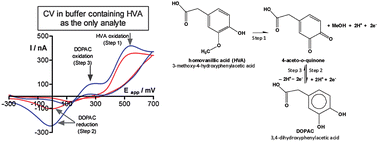The established stability of carbon-paste electrodes (CPEs) in brain extracellular fluid was exploited to develop a voltammetric technique to monitor the dopamine metabolite, homovanillic acid (HVA), at 10 s intervals. At the scan rates needed for this time resolution, 3,4-dihydroxyphenylacetic acid (DOPAC), electrogenerated as a result of HVA oxidation, was observed in the cyclic staircase voltammograms, and this interfered with the straightforward reliable quantification of HVA. However, correction of the HVA signal, recorded in mixtures, with currents from the DOPAC and ascorbate regions of the voltammogram allowed the reproducible construction of well behaved HVA calibration plots. These showed good linearity, LOD values, selectivity and stability during six days of continuous CPE exposure to a lipid medium, which served as an in-vitro model of CPE implantation in brain tissue for future applications.
You have access to this article
 Please wait while we load your content...
Something went wrong. Try again?
Please wait while we load your content...
Something went wrong. Try again?


 Please wait while we load your content...
Please wait while we load your content...